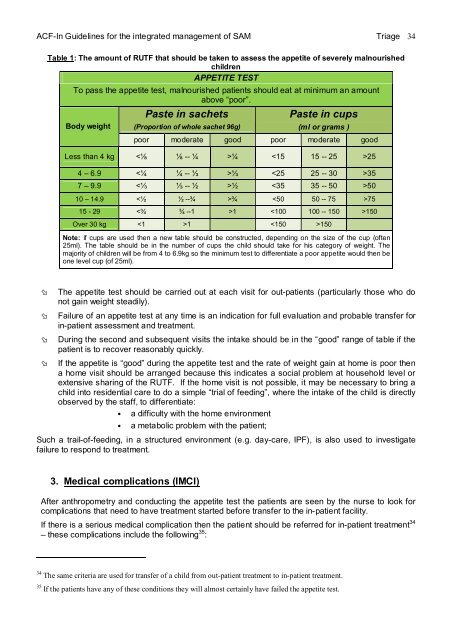guidelines for the integrated management of severe acute malnutrition
guidelines for the integrated management of severe acute malnutrition
guidelines for the integrated management of severe acute malnutrition
Create successful ePaper yourself
Turn your PDF publications into a flip-book with our unique Google optimized e-Paper software.
ACF-In Guidelines <strong>for</strong> <strong>the</strong> <strong>integrated</strong> <strong>management</strong> <strong>of</strong> SAM Triage 34<br />
Table 1: The amount <strong>of</strong> RUTF that should be taken to assess <strong>the</strong> appetite <strong>of</strong> <strong>severe</strong>ly malnourished<br />
children<br />
APPETITE TEST<br />
To pass <strong>the</strong> appetite test, malnourished patients should eat at minimum an amount<br />
above “poor”.<br />
Body weight<br />
Paste in sachets Paste in cups<br />
(Proportion <strong>of</strong> whole sachet 96g) (ml or grams )<br />
poor moderate good poor moderate good<br />
Less than 4 kg ¼ 25<br />
4 – 6.9 ⅓ 35<br />
7 – 9.9 ½ 50<br />
10 – 14.9 ¾ 75<br />
15 - 29 1 150<br />
Over 30 kg 1 150<br />
Note: if cups are used <strong>the</strong>n a new table should be constructed, depending on <strong>the</strong> size <strong>of</strong> <strong>the</strong> cup (<strong>of</strong>ten<br />
25ml). The table should be in <strong>the</strong> number <strong>of</strong> cups <strong>the</strong> child should take <strong>for</strong> his category <strong>of</strong> weight. The<br />
majority <strong>of</strong> children will be from 4 to 6.9kg so <strong>the</strong> minimum test to differentiate a poor appetite would <strong>the</strong>n be<br />
one level cup (<strong>of</strong> 25ml).<br />
� The appetite test should be carried out at each visit <strong>for</strong> out-patients (particularly those who do<br />
not gain weight steadily).<br />
� Failure <strong>of</strong> an appetite test at any time is an indication <strong>for</strong> full evaluation and probable transfer <strong>for</strong><br />
in-patient assessment and treatment.<br />
� During <strong>the</strong> second and subsequent visits <strong>the</strong> intake should be in <strong>the</strong> “good” range <strong>of</strong> table if <strong>the</strong><br />
patient is to recover reasonably quickly.<br />
� If <strong>the</strong> appetite is “good” during <strong>the</strong> appetite test and <strong>the</strong> rate <strong>of</strong> weight gain at home is poor <strong>the</strong>n<br />
a home visit should be arranged because this indicates a social problem at household level or<br />
extensive sharing <strong>of</strong> <strong>the</strong> RUTF. If <strong>the</strong> home visit is not possible, it may be necessary to bring a<br />
child into residential care to do a simple “trial <strong>of</strong> feeding”, where <strong>the</strong> intake <strong>of</strong> <strong>the</strong> child is directly<br />
observed by <strong>the</strong> staff, to differentiate:<br />
• a difficulty with <strong>the</strong> home environment<br />
• a metabolic problem with <strong>the</strong> patient;<br />
Such a trail-<strong>of</strong>-feeding, in a structured environment (e.g. day-care, IPF), is also used to investigate<br />
failure to respond to treatment.<br />
3. Medical complications (IMCI)<br />
After anthropometry and conducting <strong>the</strong> appetite test <strong>the</strong> patients are seen by <strong>the</strong> nurse to look <strong>for</strong><br />
complications that need to have treatment started be<strong>for</strong>e transfer to <strong>the</strong> in-patient facility.<br />
If <strong>the</strong>re is a serious medical complication <strong>the</strong>n <strong>the</strong> patient should be referred <strong>for</strong> in-patient treatment 34<br />
– <strong>the</strong>se complications include <strong>the</strong> following 35 :<br />
34 The same criteria are used <strong>for</strong> transfer <strong>of</strong> a child from out-patient treatment to in-patient treatment.<br />
35 If <strong>the</strong> patients have any <strong>of</strong> <strong>the</strong>se conditions <strong>the</strong>y will almost certainly have failed <strong>the</strong> appetite test.

















